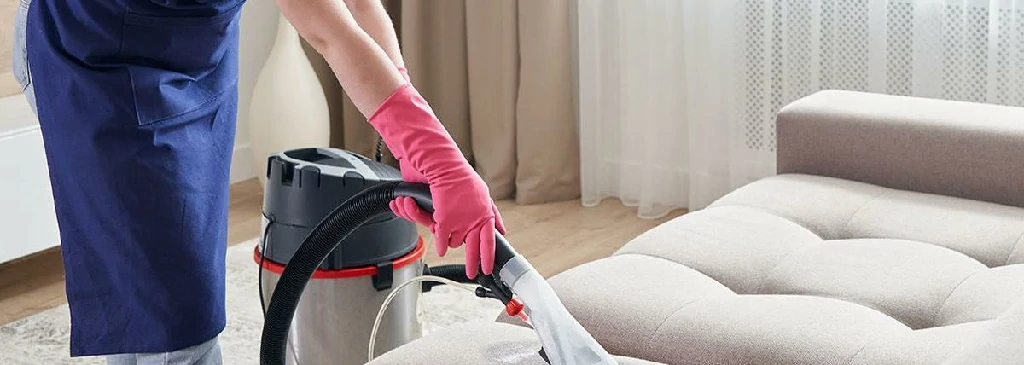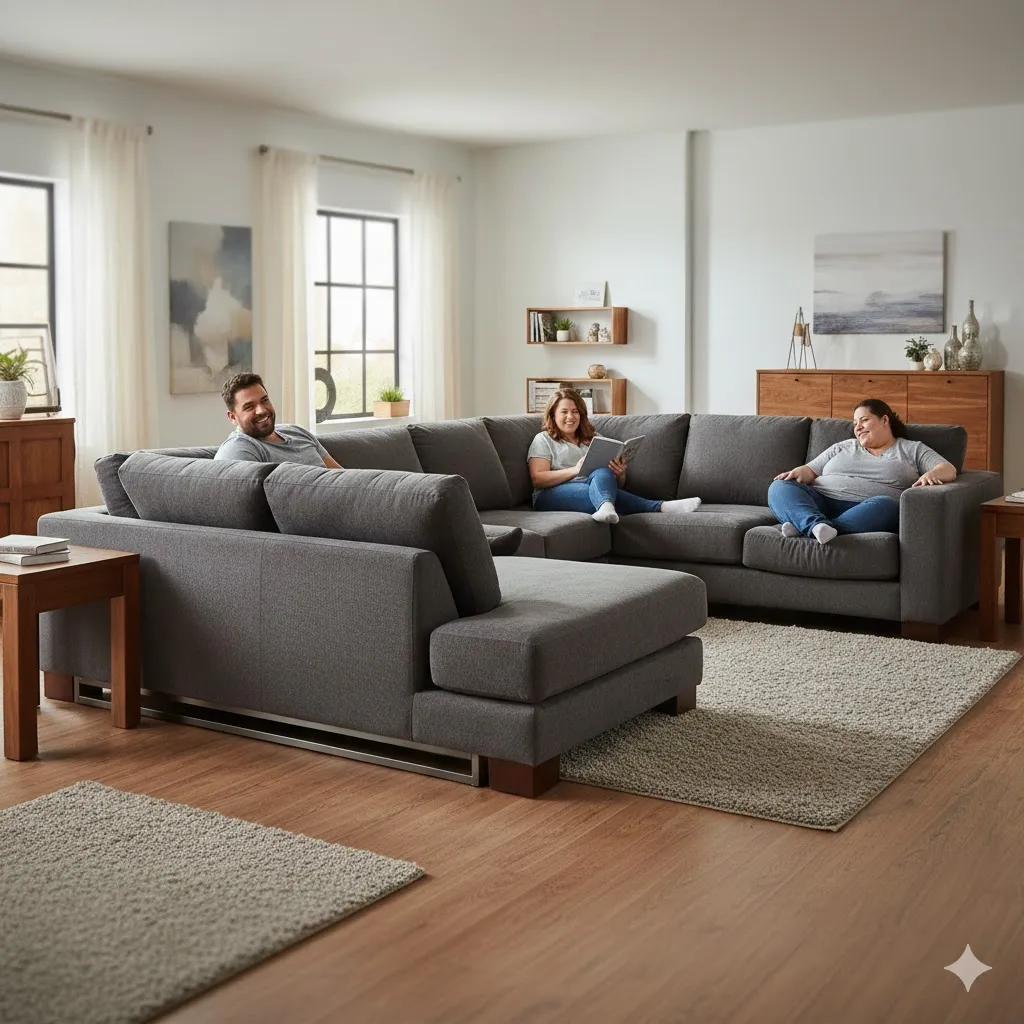Have you ever noticed your sectional sofa sinking, squeaking, or looking a little worn out? A sectional sofa is one of the most-used pieces of furniture in a home, so it’s normal for it to face issues over time. From loose screws to sagging cushions, these problems can make your sectional sofa less comfy and less stylish. The good news is, many of them are easy to fix at home. In this guide, you’ll learn what tools you might need, simple DIY fixes, and tips to keep your sectional sofa in great shape for years to come.
How to Fix a Sectional Sofa: Easy Tips for Repairs

Understanding Your Sectional Sofa
Parts of a Sectional
A sectional sofa has several key parts. The frame holds everything together. The cushions give comfort and shape. The legs support the sofa and add style. Connectors link the pieces so they don’t slide apart. The upholstery covers the sectional sofa and makes it look good.
Types of Materials
Sectional sofa come in many materials. Fabric is soft and cozy. Leather is classic, durable, and easy to clean. Microfiber is smooth and resists stains. Some sectional sofas are modular, which means you can move or swap pieces to change the layout.
How Material Affects Repairs
The material changes how you fix your sectional sofa. Fabric may need patching or sewing. Leather might need conditioning or repair kits for cracks. Microfiber often cleans up with mild soap. Modular pieces are easier to replace because you can swap out one part without buying a new sofa.
Common Sectional Sofa Problems
Sinking or Sagging Cushions
Over time, cushions can lose their shape. They may sink in the middle and feel less supportive. This makes the sofa uncomfortable and less inviting.
Loose or Broken Legs
The legs take a lot of weight. If they loosen or break, the sofa may wobble or tilt. This can also damage the frame if not fixed quickly.
Worn-Out or Torn Upholstery
Fabric or leather can wear out with daily use. Small tears, scratches, or faded spots are common problems. They make the sofa look old even if the frame is still strong.
Broken Connectors or Misaligned Sections
Sectional sofa often use connectors to keep pieces together. If they break or shift, the sections may slide apart or feel uneven. This can be annoying and unsafe.
Squeaky or Wobbly Frame
A frame that squeaks or wobbles can make the whole sofa feel unstable. It usually happens when screws loosen or joints weaken
What Causes a Wooden Frame to Break?
A broken wooden sofa frame is a frustrating but common issue, especially if your sectional is a high-traffic spot for family lounging or movie nights. Here are some typical reasons your sofa frame could fail:
- Weak or Cheap Wood: If the frame is made from soft woods like pine instead of strong hardwoods (such as oak or maple), it’s more likely to crack or snap under pressure.
- Heavy Use: Constant sitting, flopping down, or leaning on the arms or corners puts a lot of stress on joints and brackets. Over time, this can cause the frame or support brackets to weaken and break.
- Loose or Missing Screws: The screws and hardware that hold the frame together can loosen with regular use. If these aren’t tightened every so often, the parts can separate and put extra force on the wooden joints.
- Water Damage: If the sofa has been exposed to moisture—think spills, flooding, or even steam cleaning gone wrong—the wood can swell, warp, or rot, making it weaker and prone to breaking.
- Improper Assembly: If connectors, brackets, or legs aren’t installed correctly, or if factory hardware is weak, some spots of the frame might carry more weight than others. This uneven stress can eventually snap a corner or a joint.
When a wooden frame breaks, you may notice sagging in one section, a corner that gives way under weight, or even odd noises when you sit down. Being aware of these factors can help you catch issues early and keep your sectional support sturdy for years.
Tools and Supplies Needed for Repairs
Basic Toolkit
You’ll need simple tools like screwdrivers, wrenches, and pliers. These help you tighten screws, fix legs, and adjust connectors.
Upholstery Supplies
For fabric or leather fixes, keep fabric patches, glue, strong thread, and needles on hand. These are useful for patching small tears or sewing loose seams.
Cushion Repair
Cushions often lose shape, so foam, batting, and spray adhesive can help. With these, you can refill sagging cushions and make them feel firm again.
Safety Gear
Always protect yourself while working. Gloves keep your hands safe from sharp tools, and protective eyewear shields your eyes from dust or debris.
Step-by-Step Fixes
Fixing Sagging Cushions
Sagging cushions are one of the most common problems with sectional sofas, but the good news is they’re easy to fix. You can add new foam or padding inside the cushion covers to bring back their shape and firmness. Another simple trick is flipping and rotating the cushions so the wear is spread out evenly. If the sagging is more serious, placing a support board or a piece of plywood under the cushions can provide extra lift and make the sofa feel more supportive.
Repairing Loose or Broken Legs
Loose or broken legs can make your sofa unstable and unsafe. Start by checking all the screws or bolts and tightening them with the right tool. If a leg is cracked or beyond repair, replace it with a new one—many furniture stores sell replacement legs that are easy to install. For extra strength, you can reinforce the frame where the leg attaches. Adding a small bracket or plate under the sofa ensures the leg stays secure even with daily use.
Replacing a Broken Wooden Support in Your Sectional
If your sectional sofa starts to feel unstable, there might be a broken wooden support inside the frame. Here’s how you can find and replace it, step by step.
1. Access the Frame
First, carefully remove the fabric backing under your sofa. Use a flathead screwdriver or staple remover to lift the staples and gently pull back the fabric. Set it aside so you can reuse it later.
2. Locate the Broken Piece
Shine a flashlight inside the frame and look for any small wooden braces that look cracked or loose. These supports are often tucked into the corners and can sometimes be spotted moving around inside if they’ve snapped.
3. Make a Replacement
Remove the broken wooden piece and use it as a template. Using a sturdy piece of scrap wood (like pine or plywood), trace and cut a new support that matches the original shape but is thicker and stronger than the flimsy factory piece. Tools like a handsaw or a jigsaw work well for this step.
4. Secure the New Support
Drill a few pilot holes into the new wood block. Apply wood glue or a strong construction adhesive to both the block and the inside corner of the frame. Then, screw the new support into place. Using both glue and wood screws adds stability and strength.
5. Reattach the Backing
Once everything is secure and the adhesive has dried, reattach the black fabric backing with a staple gun. For a neat finish, you can tap the staples down with a hammer so they lie flat and don’t snag on anything.
With these steps, your sectional will have a reinforced frame, ready to support many more movie nights and afternoon naps.
Mending Upholstery
Upholstery damage can make a sofa look old before its time, but small repairs can extend its life. For fabric sofas, patching small tears with matching fabric or an iron-on patch works well. If you have a leather sectional, a leather repair kit can help fix cracks, scratches, and even faded spots. Loose seams can also be re-stitched with a heavy-duty needle and thread. These simple fixes not only improve the look of the sofa but also prevent further damage.
Reattaching the Fabric Backing
Once your repairs are done, it’s time to reattach the dust cover (that thin black fabric on the sofa’s underside). Start by stretching the backing fabric back into place so it covers the opening evenly. Use a staple gun to secure the edges, working your way around and keeping the fabric taut as you go. For a neat finish and extra hold, go over the staples with a hammer to make sure they’re flush with the frame. This way, the fabric won’t snag on floor or ottoman as you slide pieces in and out, and everything looks tidy and professional.
Fixing Section Connectors
Sectional sofas rely on connectors to keep the pieces aligned, and when those fail, the sofa may slide apart. Begin by checking the connector brackets or clips and tightening them if they’re loose. If a connector is broken, replace it with a new one designed for sectionals. Once everything is in place, realign the modular pieces so they fit snugly together. This will keep the sofa steady and give it a seamless look.
Fixing a Wobbly or Squeaky Frame
A wobbly or squeaky frame can be distracting and uncomfortable. The first step is to tighten all screws and bolts holding the frame together. If squeaks persist, lubricate the joints or brackets with a small amount of furniture-safe oil. For frames that feel weak or unstable, add extra support by attaching brackets or wooden reinforcements. These small adjustments can make the sofa feel solid and extend its overall lifespan
Attaching a New Wooden Support to the Frame
If you need to reinforce a damaged or weak section of your sofa frame, adding a new wooden support is a solid repair—and it’s easier than you might think. Here’s how you can do it with basic materials and a bit of patience:
Remove the Fabric Backing
Start by gently pulling out the staples that secure the dust cover or black backing fabric underneath your sofa. Use a staple remover or flathead screwdriver for this step, making sure you don’t tear the fabric so you can reattach it later.Measure and Cut a Replacement Support
Locate the broken or missing wood brace inside the frame, usually found at the corners. If there’s a piece left, use it as a template to trace the shape onto a thicker, sturdier piece of scrap wood—hardwood plywood or pine works well for this kind of repair. Cut out the replacement with a saw so it fits snugly in the corner.Drill Pilot Holes
To make assembly easier and prevent the wood from splitting, drill pilot holes in the new corner block where the screws will go. Doing this before you install the block is helpful, especially if the space is tight.Apply Wood Glue or Construction Adhesive
Coat both the new block and the area inside the sofa frame where it will sit with a strong wood glue or construction adhesive such as Gorilla or Liquid Nails. This bonds the pieces together and adds extra strength.Secure the Block with Screws
Position the block firmly in the corner and drive screws through the pre-drilled holes, anchoring it securely to both joining pieces of the frame. The combination of glue and screws ensures a tight, long-lasting support.Replace the Fabric Backing
Once the repair is set and the adhesive has dried, staple the dust cover or backing fabric back into place to finish the job.
With just a bit of handiwork, your sectional can get a sturdier frame that’s ready to withstand years of lounging.
Maintenance Tips to Prevent Future Problems
To keep your sectional sofa in good shape for years, a few simple habits can make a big difference:
- Rotate cushions regularly – This helps distribute wear evenly and keeps them from sagging on one side.
- Avoid jumping or heavy loads – Extra pressure can damage the frame and shorten the sofa’s lifespan.
- Keep it away from direct sunlight and moisture – Sunlight fades fabric and leather, while moisture can weaken wood or cause mold.
- Check screws, connectors, and legs often – Tighten or replace them when needed to prevent bigger issues.
What If Your Sectional Is Under Warranty but No Longer Available?
Sometimes you’ll run into a situation where your sectional is still under warranty—but the exact model is no longer made. Here’s what usually happens, and your options if this curveball comes your way:
- Credit or Replacement: Most major furniture brands will offer you either store credit for the original purchase price or a replacement with a similar model.
- Assessing Fit: If your original sofa fit your space perfectly and none of the current models will work, you might need to get creative. Consider using the credit for other pieces like an accent chair, ottoman, or storage furniture—even if a sectional isn’t available in the right size.
- Negotiating Options: Don’t be shy about discussing alternatives with customer service. Some companies may offer extra flexibility, such as extended time to use your credit or an upgrade to a comparable model at no extra charge.
- Resale or Gifting: If you truly can’t use any other furniture from the retailer, another option is to resell unwanted items or pass them along to friends or family.
The key is to double-check warranty terms and work with the retailer to find the best alternative, especially if your space and decor needs are unique. Even if the discontinued model throws a wrench in your plans, you can still turn the situation to your advantage with a bit of patience and flexibility.
Common Mistakes to Avoid
While fixing a sectional sofa can be simple, certain mistakes may lead to bigger problems. One common error is using the wrong tools or adhesives. For example, strong industrial glue might damage upholstery or make future repairs difficult. Another mistake is ignoring the manufacturer’s care instructions, since different materials—such as leather, fabric, or microfiber—require specific cleaning and repair methods. Lastly, attempting a quick DIY repair without proper knowledge can worsen the issue, turning a minor fix into an expensive replacement. Taking time to research and use the correct methods will keep your sofa in better shape for longer.
Conclusion
Fixing a sectional sofa doesn’t have to be complicated. With the right tools and a little care, you can handle most issues—from sagging cushions to loose legs—without calling in a professional. Regular maintenance, like rotating cushions and checking connectors, goes a long way in preventing small problems from turning into costly repairs. Treat your sectional with care, and it will stay comfortable and stylish for years to come. If you’re ready to get started, explore reliable repair tools and products that can help you keep your sectional looking and feeling like new.





